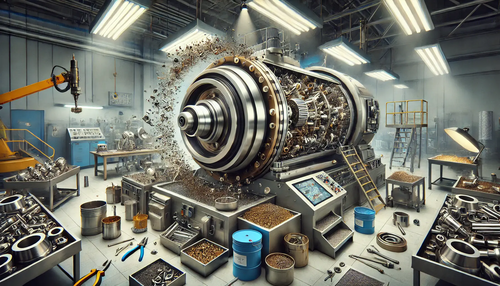Centrifugal finishing is a highly efficient mass finishing process used in various industries to improve the surface quality of metal, plastic, or ceramic parts. The method utilizes centrifugal force to enhance the abrasive action against the surfaces of workpieces. This process is widely adopted in manufacturing, particularly in automotive, aerospace, and jewelry industries, for its ability to achieve high-quality finishes in a relatively short amount of time.

The Basics of Centrifugal Finishing
Centrifugal finishing, also known as centrifugal barrel finishing or centrifugal mass finishing, involves placing workpieces and abrasive media into a rotating barrel or bowl. This barrel is mounted on a rotating base that spins around its axis. The combination of rotational and centrifugal forces within the barrel creates a high-energy environment that accelerates the finishing process.
The fundamental principles of centrifugal finishing rely on the generation of a high G-force environment, where "G" represents the acceleration due to gravity. This force is significantly higher than that in conventional vibratory finishing, making centrifugal finishing more effective for specific applications.
The Process
- Loading the Equipment: The process begins with placing the workpieces and abrasive media (such as ceramic, plastic, or metallic tumbling media) into a rotating barrel or bowl. The choice of media depends on the desired finish and the nature of the workpieces.
- Centrifugal Action: As the barrel rotates, the centrifugal force pushes the media and workpieces against the walls of the barrel. This action creates a highly energetic environment where the media rubs against the surfaces of the workpieces, performing tasks such as deburring, polishing, and smoothing.
- Controlling the Process: Various parameters, such as rotation speed, process time, and the type of abrasive media, can be adjusted to control the quality of the finish. Different media and additives might be used based on the specific requirements of the finishing task.
- Cleaning and Drying: After the finishing process is complete, the workpieces and media are separated. The workpieces are typically rinsed to remove any residue and then dried to prevent rust or other forms of corrosion.
Advantages of Centrifugal Finishing
- Efficiency: Centrifugal finishing processes are much faster than traditional methods. The high G-forces generated during the process significantly speed up the removal of material and the achievement of the desired surface finish.
- Consistency: The controlled environment of centrifugal finishing provides a uniform and consistent finish across all workpieces. This is particularly important in high-volume production settings where uniformity is crucial.
- Precision: Due to its high energy and precise control, centrifugal finishing can achieve finer finishes and tighter tolerances than many other finishing techniques.
- Versatility: This method is adaptable to a wide range of materials, including metals, plastics, and ceramics. It can handle various part shapes and sizes, making it a flexible choice for different applications.
- Reduced Labor Costs: Automated centrifugal finishing systems require less manual intervention, which can lead to significant labor cost savings in manufacturing.
Applications
- Automotive Industry: In automotive manufacturing, centrifugal finishing is used to deburr and polish engine components, transmission parts, and other metal parts. It helps improve the performance and longevity of these components by ensuring a smooth and defect-free surface.
- Aerospace Industry: Aerospace components often require precise and high-quality finishes to meet stringent industry standards. Centrifugal finishing helps achieve the necessary surface integrity and precision for critical aerospace parts.
- Jewelry Manufacturing: In the jewelry industry, centrifugal finishing is employed to polish and smoothen precious metals and gemstones, enhancing their appearance and value.
- Medical Devices: For medical devices, which must adhere to strict hygiene and precision standards, centrifugal finishing provides the necessary surface smoothness and cleanliness.
Challenges and Considerations
- Material Selection: Choosing the right type of abrasive media is crucial for achieving the desired finish. The media must be compatible with both the workpieces and the desired finish quality.
- Equipment Maintenance: Regular maintenance of the centrifugal finishing equipment is necessary to ensure consistent performance. Wear and tear on the barrel, media, and other components must be monitored and addressed.
- Process Optimization: Fine-tuning the process parameters, such as rotation speed and process time, is essential for optimizing the finishing results and avoiding potential issues like excessive wear or damage to the workpieces.
- Cost Considerations: While centrifugal finishing can reduce labor costs and improve efficiency, the initial investment in high-quality equipment can be substantial. It’s important to weigh these costs against the long-term benefits of increased productivity and quality.
Conclusion
Centrifugal finishing stands out as a powerful and efficient technique for achieving high-quality surface finishes on a variety of workpieces. Its ability to deliver consistent, precise results in a short amount of time makes it an invaluable tool in modern manufacturing. By understanding its principles, advantages, and applications, businesses can leverage centrifugal finishing to enhance product quality, improve operational efficiency, and maintain a competitive edge in their respective industries.

